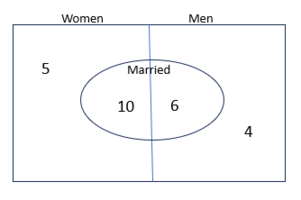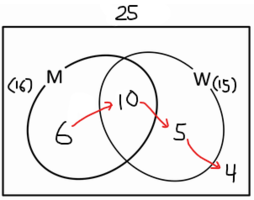You are using an out of date browser. It may not display this or other websites correctly.
You should upgrade or use an alternative browser.
You should upgrade or use an alternative browser.
Venn diagram: "Out of 25 teachers, 16 are married and 15 are women. If 6 of the men..."
- Thread starter chijioke
- Start date
Dr.Peterson
Elite Member
- Joined
- Nov 12, 2017
- Messages
- 16,116
The sets you show should represent one thing at a time; combining "men" and "not married" into the definition of one set complicates things.View attachment 36359U={all the teachers}
M={men not married}
D={women not married}
View attachment 36360
Also, as in the other thread, you don't need separate sets for "men" and "women"; if you have one for men, then women are "not men" (that is, everything outside that set); you don't need a separate set for women.
I would have one for "men" and another for "married"; or, if you prefer, one for "women" and another for "single", so that the goal is to find the intersection of those.
pka
Elite Member
- Joined
- Jan 29, 2005
- Messages
- 11,971
Suppose that [imath]A\text{ is the set of women teachers, }B\text{ is the set of men teachers and }C\text{ is the set of married teachers.} [/imath]
Note that [imath]\bf A \cap B = \emptyset [/imath] So [imath]\#(B\cap C)=6[/imath] , [imath]\#(A\cap C)=10[/imath]
[imath]\#(B\cap (A\cup C)^c)=4[/imath] and [imath]\#(A\cap (B\cup C)^c)=5[/imath]
As I have shown in the diagram, 4 men and 5 women teachers are not married. 16 teachers both men and women are married. So the area outside show those who are married. They have nothing common. So that's why the intersection is an empty set.The sets you show should represent one thing at a time; combining "men" and "not married" into the definition of one set complicates things.
Also, as in the other thread, you don't need separate sets for "men" and "women"; if you have one for men, then women are "not men" (that is, everything outside that set); you don't need a separate set for women.
I would have one for "men" and another for "married"; or, if you prefer, one for "women" and another for "single", so that the goal is to find the intersection of those.
BigBeachBanana
Senior Member
- Joined
- Nov 19, 2021
- Messages
- 2,182
I recommend making a 2-ways table for this problem, however, I have a feeling that you want to practice with Venn Diagrams and sets.As I have shown in the diagram, 4 men and 5 women teachers are not married. 16 teachers both men and women are married. So the area outside show those who are married. They have nothing common. So that's why the intersection is an empty set.
| Men | Women | Total | |
| Married | |||
| Not married | |||
| Total |
Dr.Peterson
Elite Member
- Joined
- Nov 12, 2017
- Messages
- 16,116
You have the right numbers. Unfortunately, the diagram doesn't show that, and in particular it is not useful in solving the problem or in showing that your solution is correct, because it has no place to show the 15 women or the 6 married men.As I have shown in the diagram, 4 men and 5 women teachers are not married. 16 teachers both men and women are married. So the area outside show those who are married. They have nothing common. So that's why the intersection is an empty set.
And the diagram is what you asked about:
View attachment 36359Definitions:
U={all the teachers}
M={men not married}
D={women not married}
View attachment 36360
Is my Venn diagram correct?
If your goal is to learn to make Venn diagrams, you have to correct it.
Is there a reason you choose not to follow my advice on how to do that?
But the question demands of the women not married. Not the married ones.You have the right numbers. Unfortunately, the diagram doesn't show that, and in particular it is not useful in solving the problem or in showing that your solution is correct, because it has no place to show the 15 women or the 6 married men.
And the diagram is what you asked about:
If your goal is to learn to make Venn diagrams, you have to correct it.
Is there a reason you choose not to follow my advice on how to do that?
But my Venn diagram is showing this already.I recommend making a 2-ways table for this problem, however, I have a feeling that you want to practice with Venn Diagrams and sets.
Men Women Total Married 6 10 16 Not married 4 5 9 Total 10 15 25
Dr.Peterson
Elite Member
- Joined
- Nov 12, 2017
- Messages
- 16,116
No, it doesn't make all of those numbers apparent. Several can't even be deduced from it. A proper diagram will show everything this table does.But my Venn diagram is showing this already.
Why do you say this? The diagram I'd make shows everything you need:But the question demands of the women not married. Not the married ones.
M = married people
W = women
The unmarried women are [imath]M'\cap W[/imath].
Given that there are 6 married men ([imath]M\cap W'[/imath]), that leaves 16 - 6 = 10 women who are married, which leaves 15 - 10 = 5 women who are unmarried (the answer to the question, [imath]M'\cap W[/imath]); and the total is 21, leaving 4 who are neither married nor women.
All these numbers are in my diagram; only 4, 5, and 16 are in yours. You totally missed the distinction of men vs women who are married, and the set of all women.
This is because you did not use fundamental sets like women and married.
Harry_the_cat
Elite Member
- Joined
- Mar 16, 2016
- Messages
- 3,696
The problem here is that you have two disjoint pairs of sets.
1. Men and women (ie these sets do not intersect with each other)
2. Married and Not-married (same here)
One way to represent this in a Venn diagram is to split the Universal set into two.

Venn Diagrams are not always the best way to represent data like this. A two-way table as in Post #6 would be more appropriate.
A bit like using a spanner to hammer in a nail!
1. Men and women (ie these sets do not intersect with each other)
2. Married and Not-married (same here)
One way to represent this in a Venn diagram is to split the Universal set into two.

Venn Diagrams are not always the best way to represent data like this. A two-way table as in Post #6 would be more appropriate.
A bit like using a spanner to hammer in a nail!
At least did not use a screw-driver!A bit like using a spanner to hammer in a nail!
Thank you everybody for your interest in ensuring that I understand this Venn diagram concept. What I will do now is to go and study the previous thread and this very thread I created concerning Venn diagram construction and come with another thread to show that I have understood the concept. Thanks once again.



